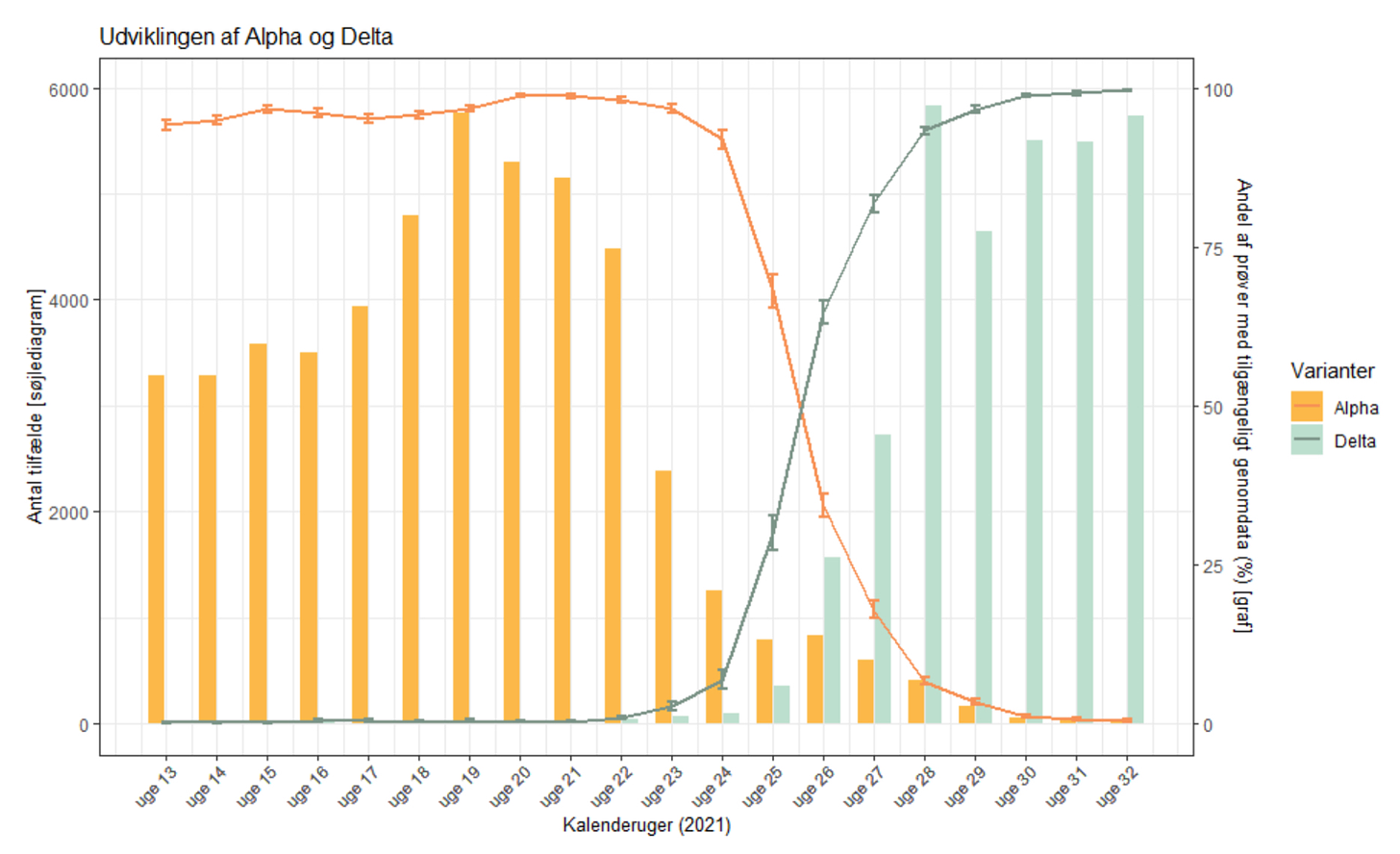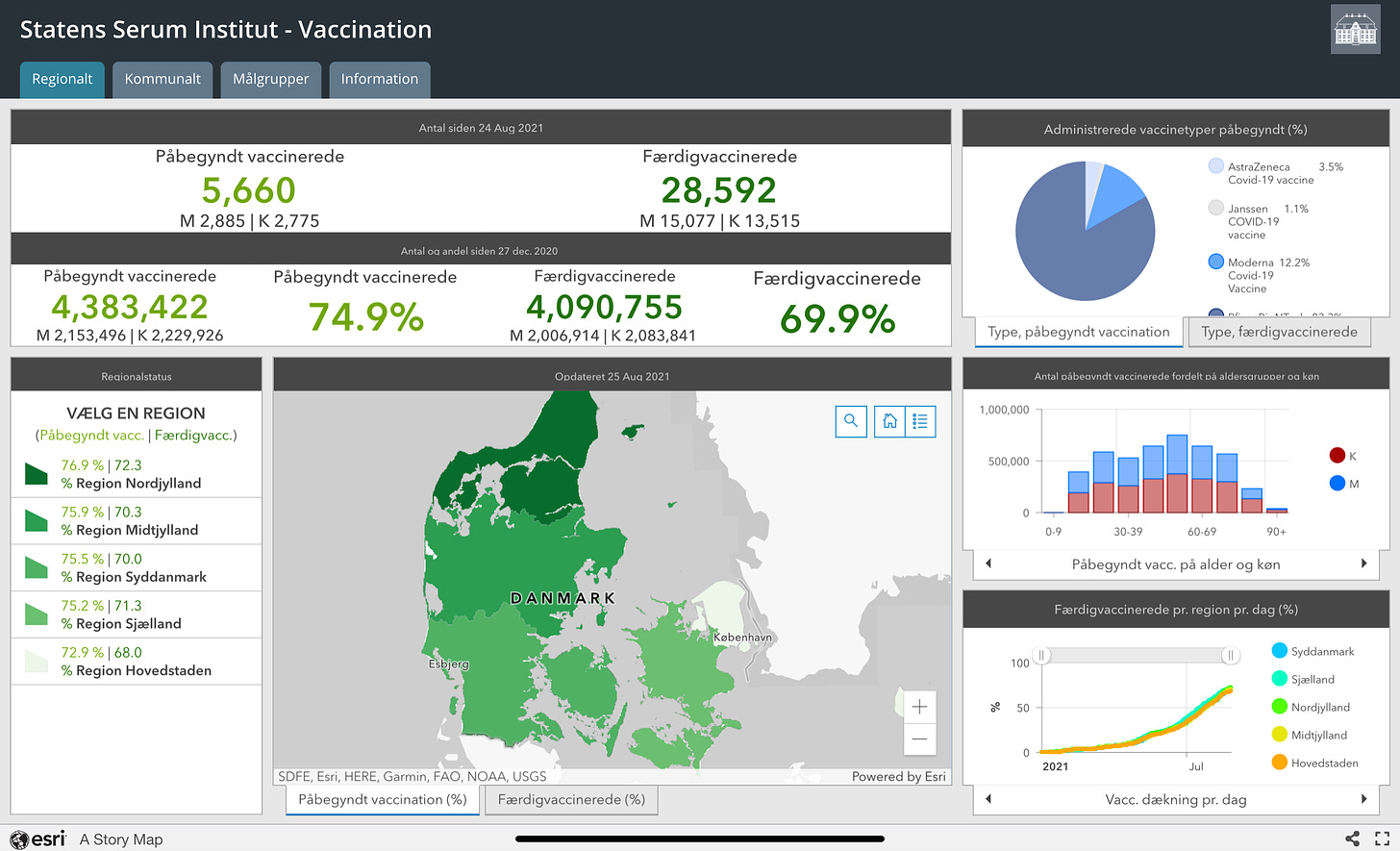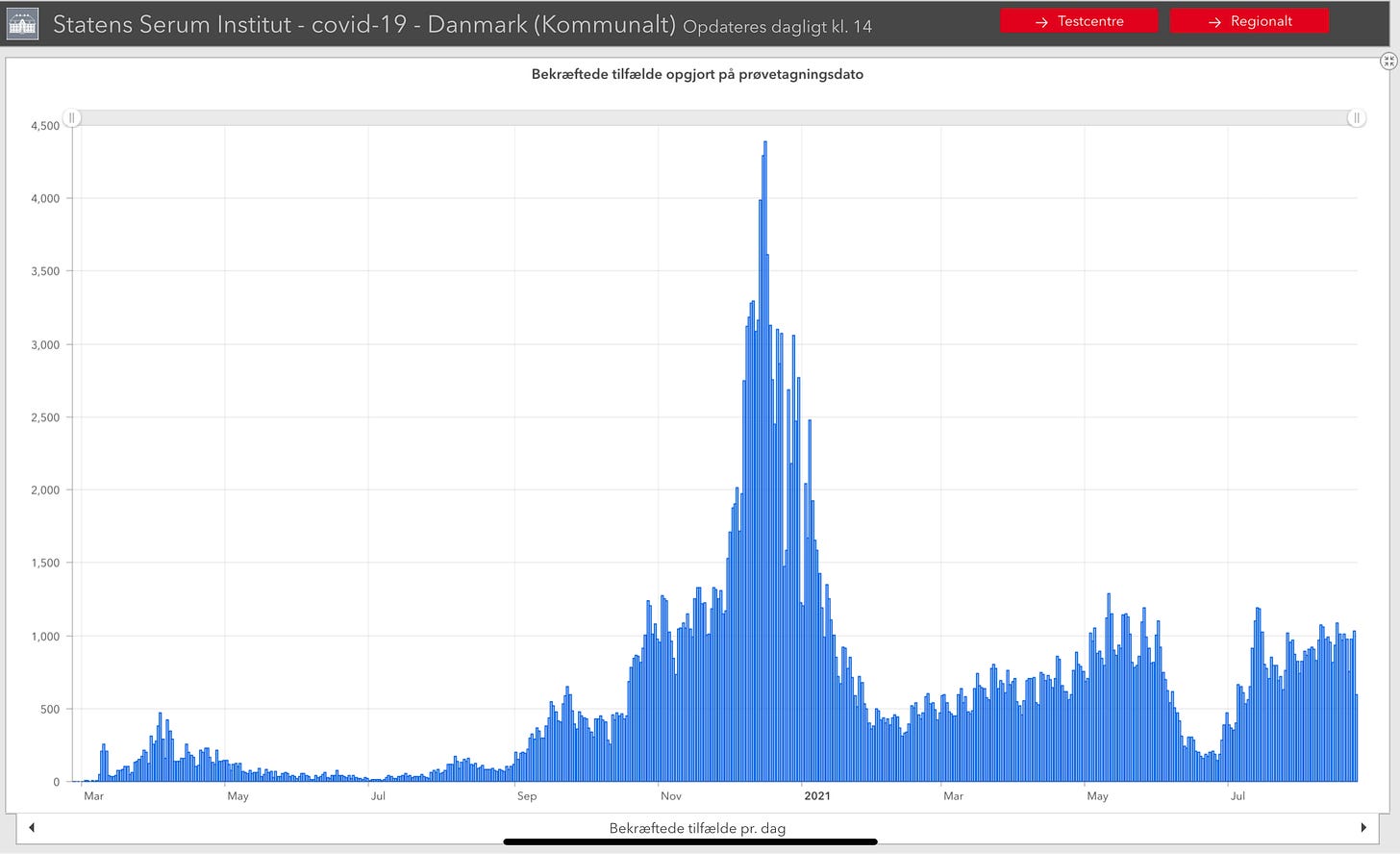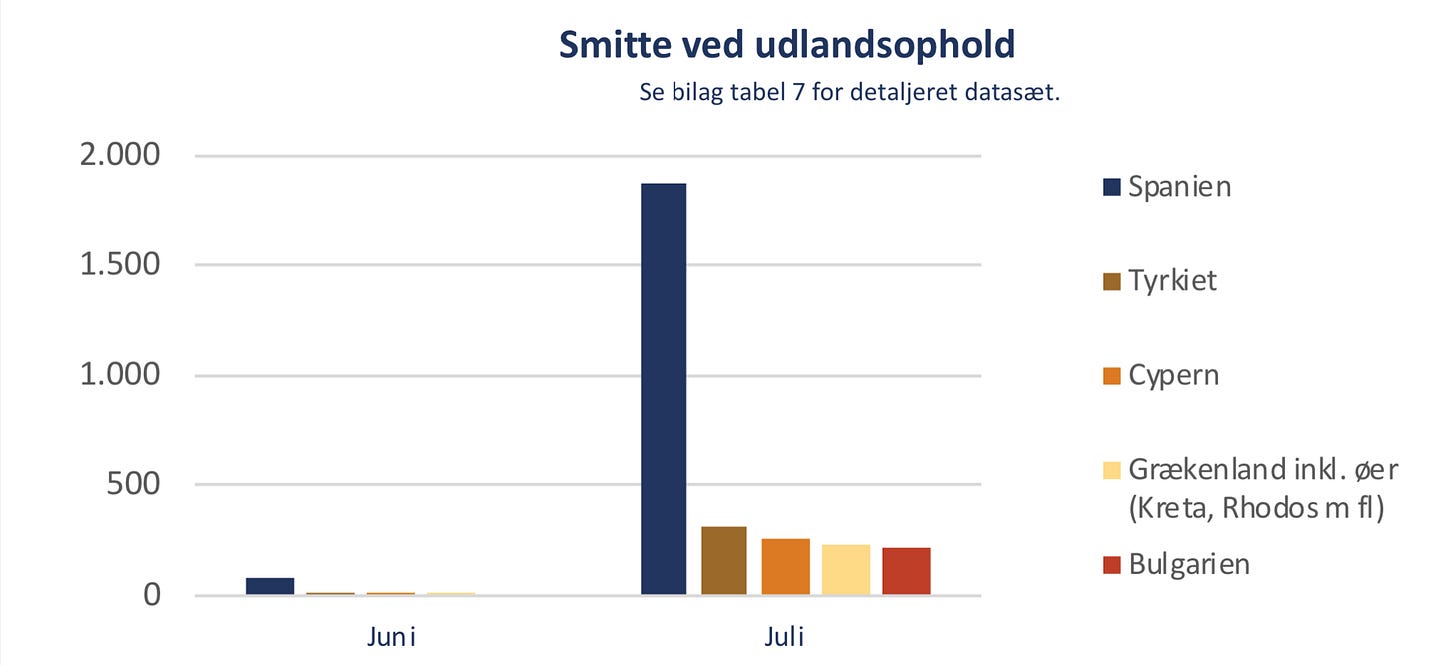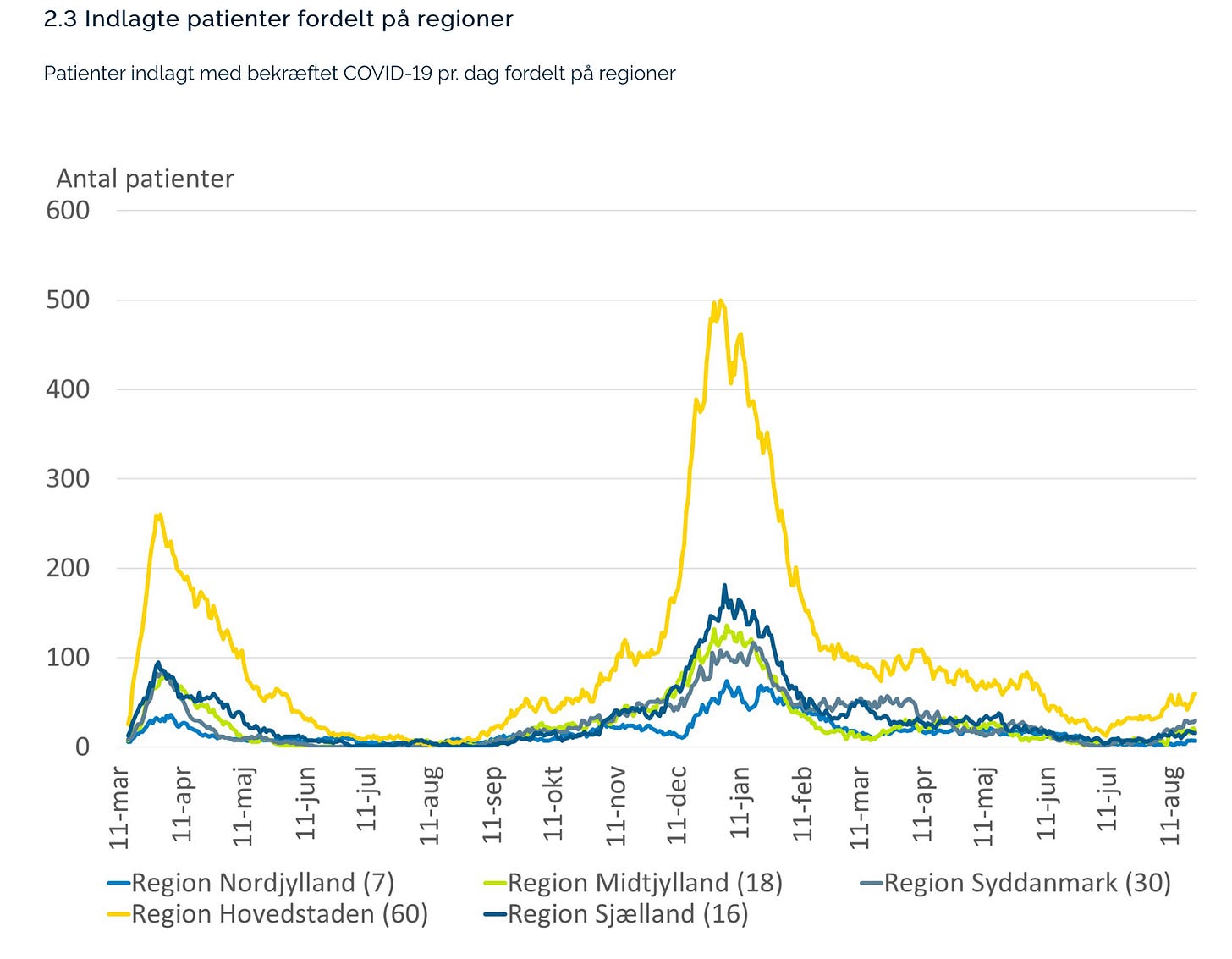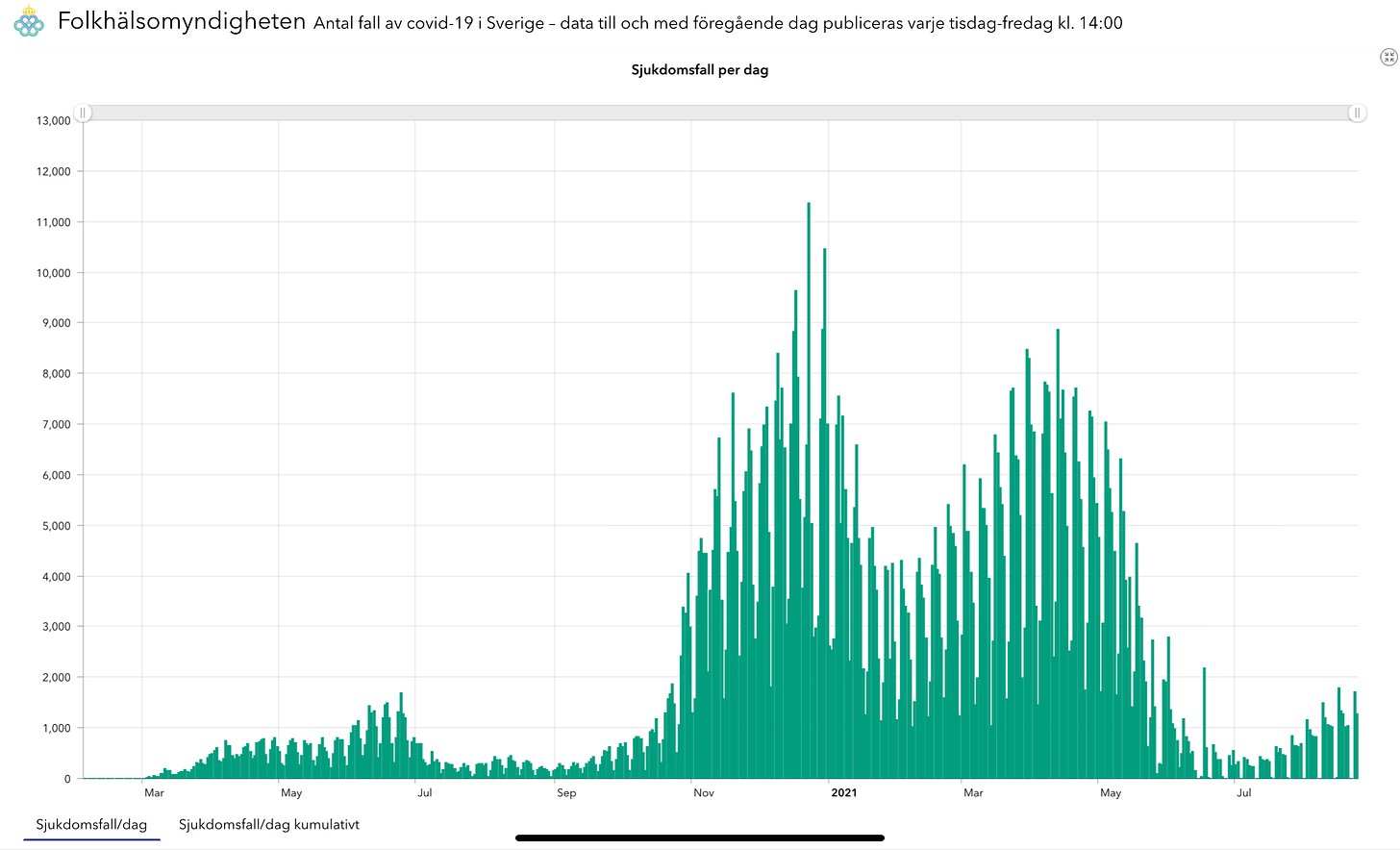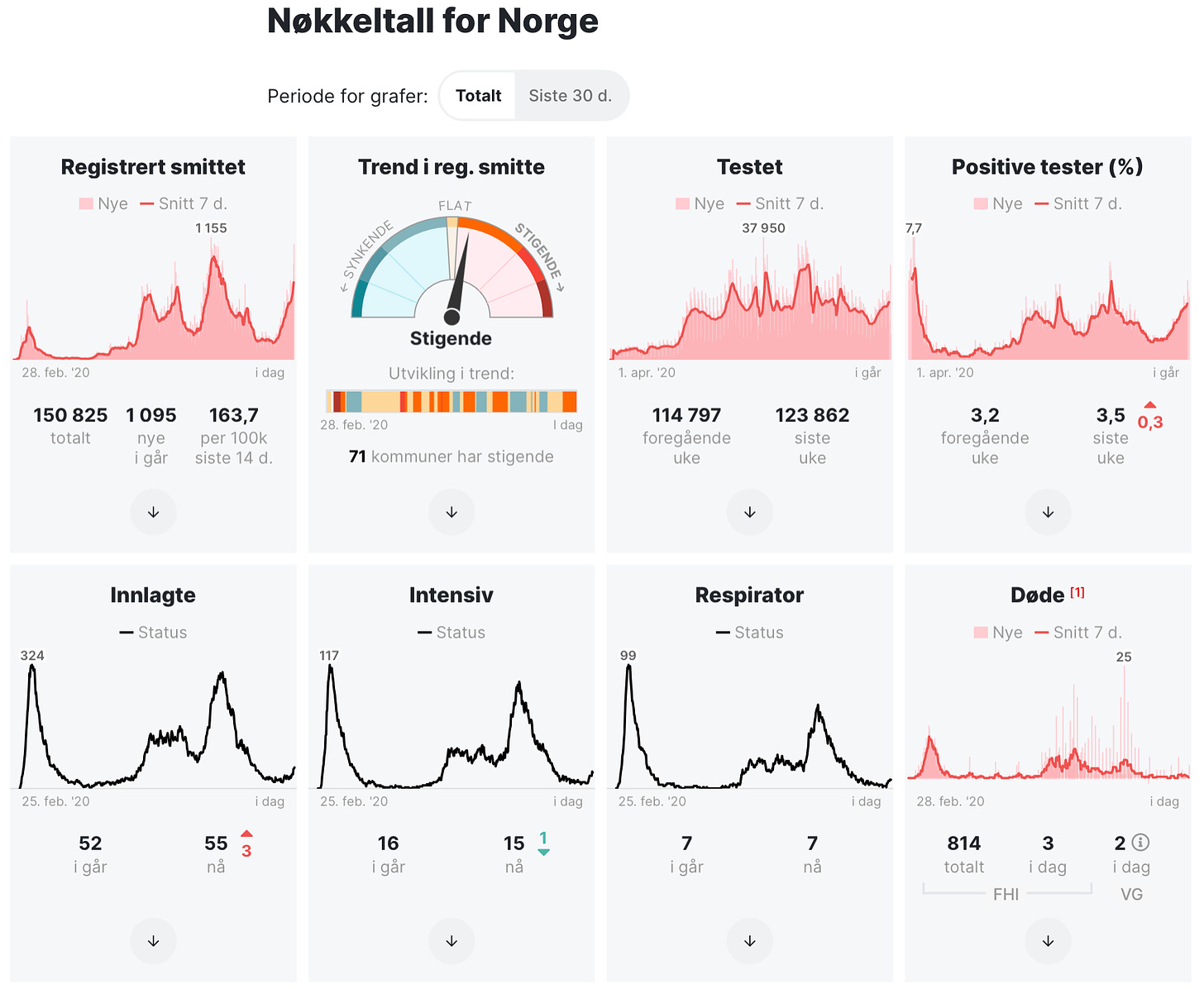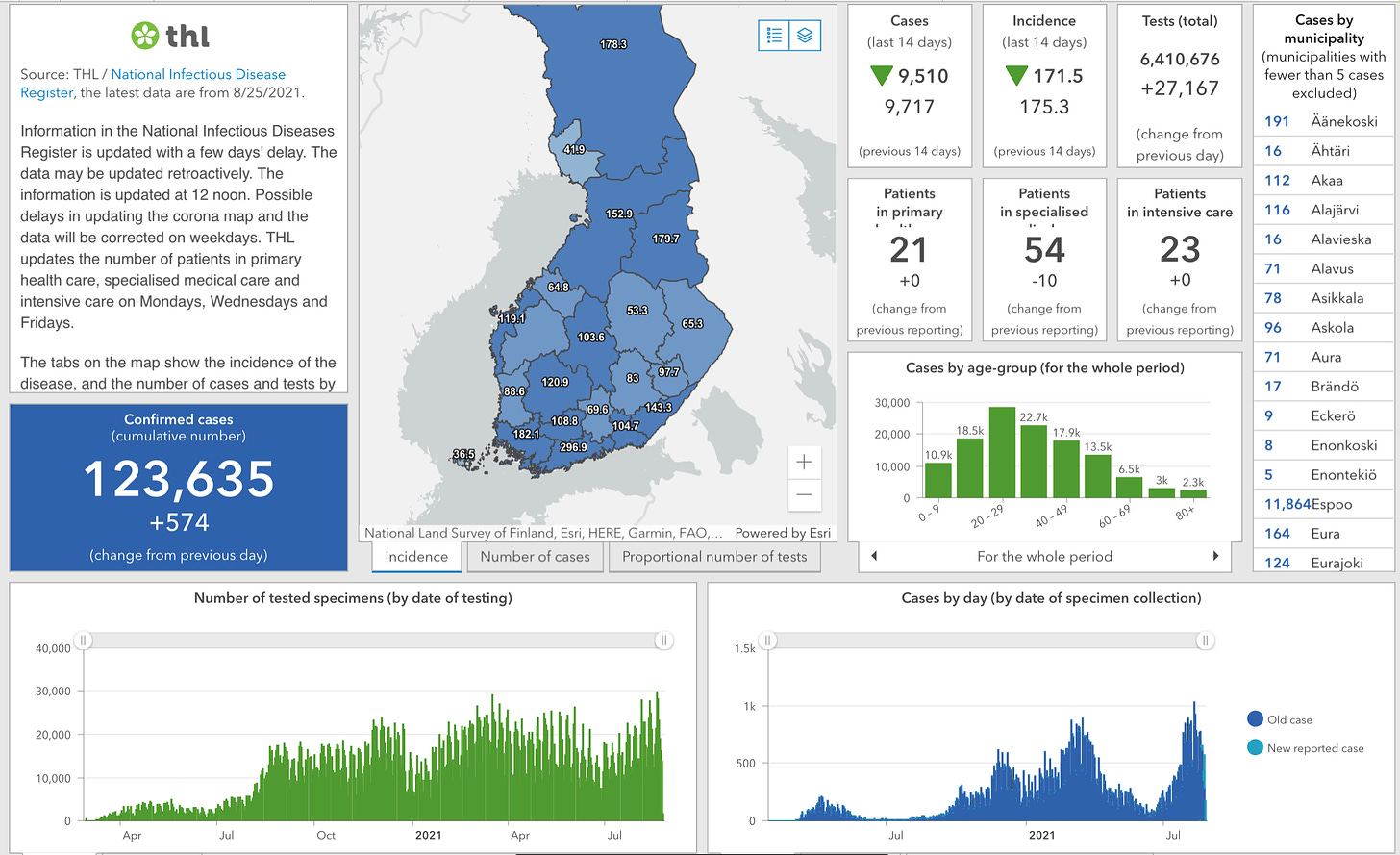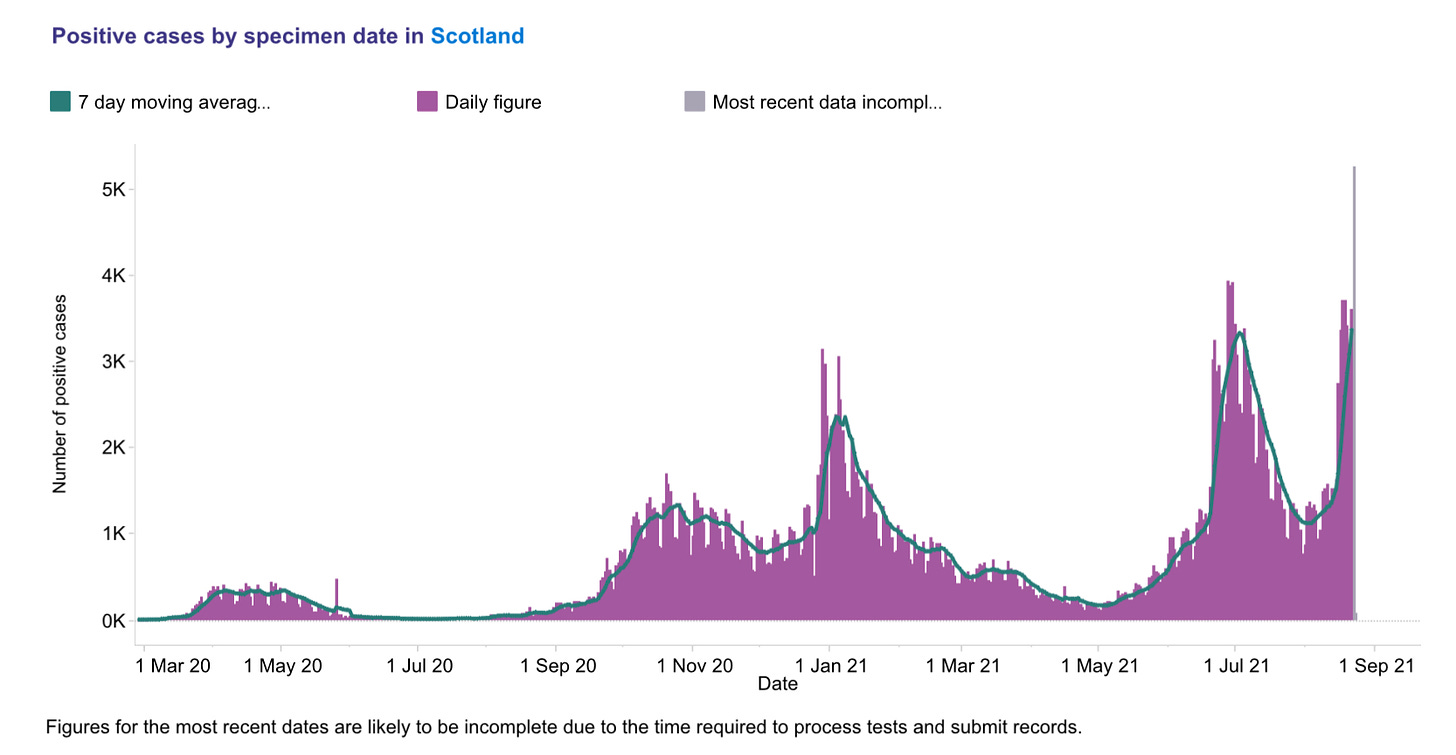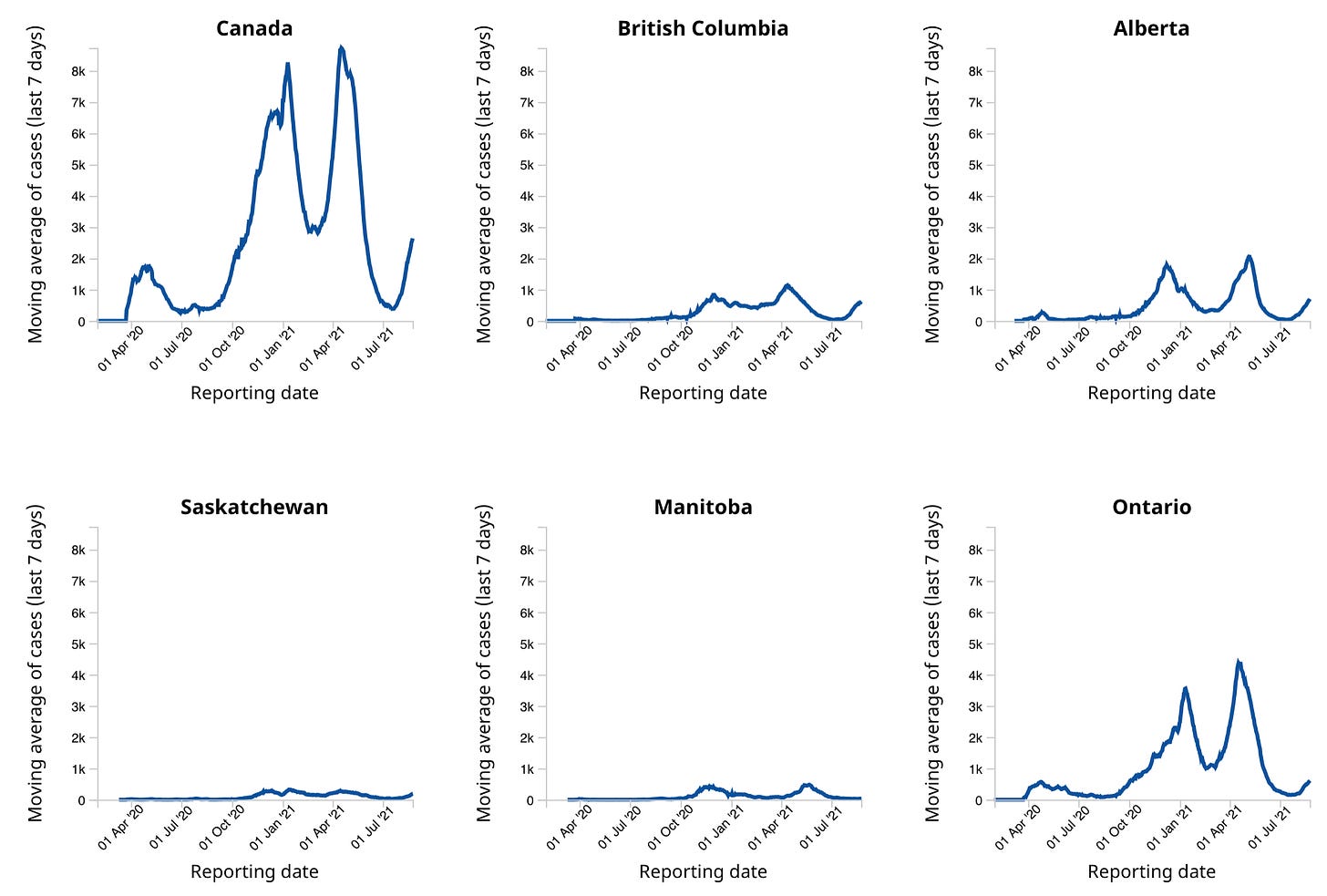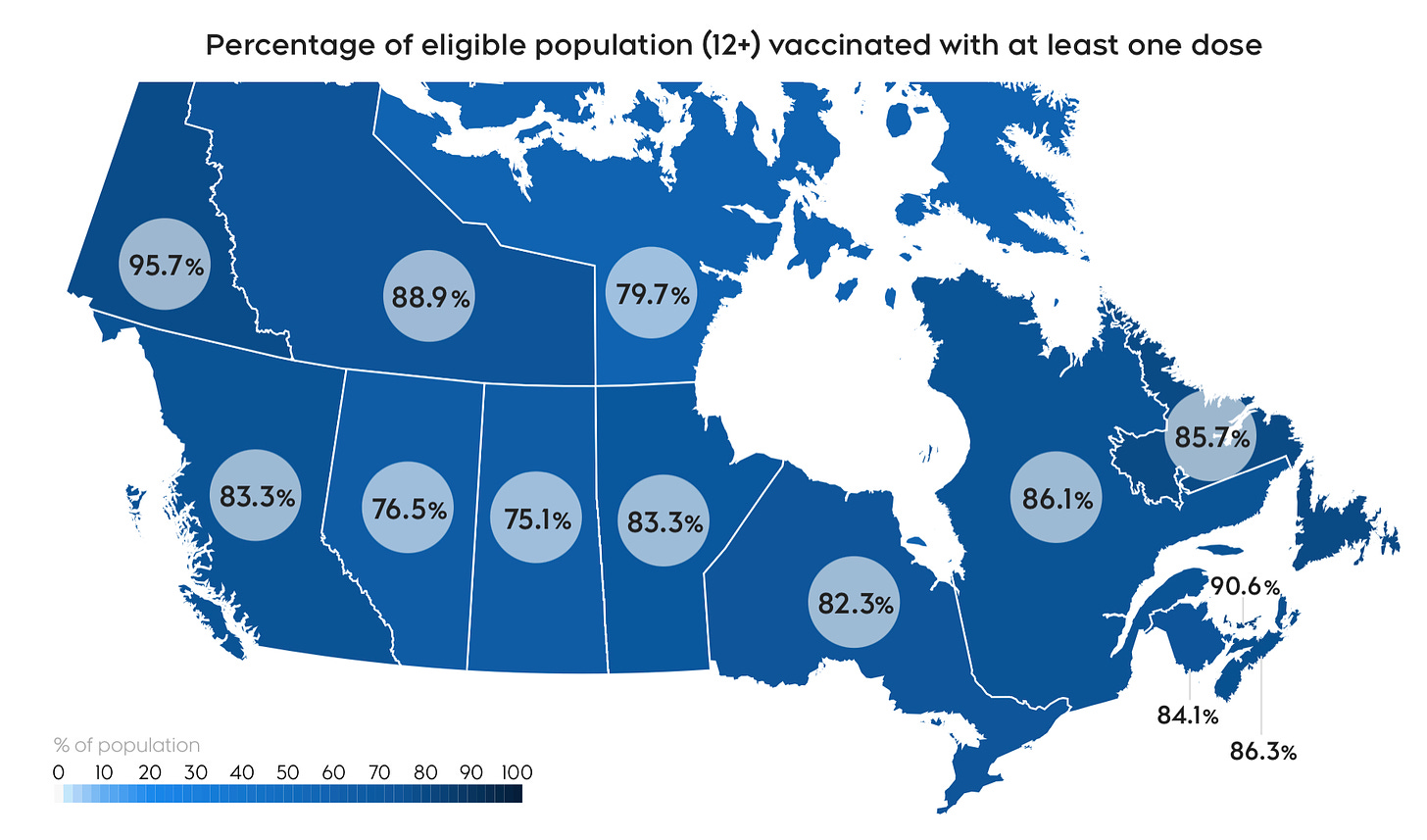The Evening Report - Aug 25
Danish students are sent home as parishes close and infections spread
🇩🇰
Breaking News from DR on the months long nurses strike. The government will move to legislate striking nurses back to work and impose a contract on them. DR reports the government would mandate a wage increase of about 5.5%, which is in line with other public sector agreements. However, the legislation will require a clear majority vote in the Danish parliament to be enacted.
Earlier today, the Danish National Health Board had assessed the strike was causing major backlogs in a number of procedures and surgeries that could take more than a year to clear up.
-
The Delta variant remains so absolutely dominant in Denmark that for a third straight week there has not been a single confirmed case of any other variant of concern. Since last week’s variant update, the Staten Serum Institut says there have been another 2,920 confirmed Delta variant cases pushing the total to date to 34,234.
The dominance of the Delta variant is very evident when compared to the Alpha variant, which triggered a global infection wave and forced Denmark into another lockdown. In Denmark, the Delta variant has virtually driven the Alpha variant into extinction.
-
Five days and five districts locked down.
Number four is Vollsmose Parish in Odense, which has hit all three criteria dictating an automatic lockdown beginning today. All schools, colleges, universities, sports facilities, libraries, and cultural institutions and activities must be closed down. The district has an incidence rate over 1,000, a positivity percentage of 8.22, well over the benchmark of 3, and has recorded 100 new infections over the last seven days, also exceeding the limit of 20.
Odense Kommune is urging Vollsmose residents who have not been vaccinated to get their shots. The city’s vaccination sites all take walk-ins with no appointment required. The municipality is also asking people in Vollsmose to get tested at least twice a week.
The fifth is Tvis Parish in Holstebro Kommune, which will have to close down as of tomorrow after exceeding all three criteria triggering an automatic lockdown. The kommune is also urging people to get vaccinated and get tested. It also advises employees, if possible, to work from home.
None of the parishes can reopen until at least one of the three criteria sinks below the threshold and stay there for seven straight days.
-
The number of COVID cases among children has rocketed up since students returned to class at the beginning of August. With five different parishes locked down in different areas of the country, a number of schools have had to close down, threatening things like field trips and confirmations. For example, in one school in Central Jutland some 350 students have been sent home.
Numbers from the Staten Serum Institut show that in the last week of June there were about 300 children and teens who had become infected. This compares to over 3,200 COVID cases among young people in just the last week.
Speaking to DR, SDU Microbiology Professor Hans Jørgen Kolmos says the impacts ripple out when children are sent home from school.
“When the children are sick, there must be someone to look after them. Whether the parents are vaccinated or need to be quarantined, the children need to be cared for. It is like a fire, once it catches it just spread affecting everything around it.”
Children who are sent home from school due to infections should get tested on days four and six, as should their parents, even if they are fully vaccinated. A quarantine would only be required if there is a positive test.
The Danish National Health Board relaxed COVID guidelines in schools and isolation rules just before the new school year.
-
As Denmark’s vaccination strategy shifts to targeting young people, workplaces, and neighborhoods with lagging vaccination rates, Region Sjælland has already deployed its mobile vaccination sites. It was operating a pop-up site in Kalundborg today. The region says the doctor on hand was able to speak Arabic and could field any vaccine questions on top of giving shots.
-
On the vaccination front to date, 4,383,422 1st doses (74.9% of the total population) have been administered while 4,090,755 people (69.9%) are fully vaccinated.
Yesterday there were 34,252 total inoculations done and of those just 5,660 were 1st doses.
-
Denmark is reporting 987 COVID infections and three more coronavirus deaths since Tuesday’s update.
Yesterday there were 163,548 total corona tests done, 76,320 PCR and 87,228 rapid, for a (PCR only) positivity percentage of 1.29%.
-
The Danish Agency for Patient Safety says Spain was far and away the highest infection risk when Danes headed out of the country for summer holidays in July. Last month it recorded at least 1,875 infections in travelers coming from Spain. That is compared to 315 travel-related infections from Turkey, the second highest infection-risk travel destination on the list.
-
COVID hospitalizations (133) crept upward (+2) while the number of infected people in an ICU (21) also inched up (+1) and of those the number on a ventilator (7) also edged up (+1).
-
Researchers at Odense University believe they have found a way to measure which cancer patients should be a priority for a COVID booster shot. A research project mapped how the immune system of some 524 cancer patients developed after being vaccinated.
Research lead Henrik Ditzel, who is chief physician and professor at Odense University Hospital, spoke to Ritzau.
"Our research provides important knowledge in relation to who needs a third dose, and I believe that it must be the haematological cancer patients and those who have received chemotherapy during the vaccination process who must have the booster shot.”
The research found patients with haematological cancers do not produce as many antibodies after being fully vaccinated as those who had breast, lung, prostate, and colon cancers.
Haematological cancers include lymphatic leukemia, lymphoma, and multiple myeloma.
🇸🇪
Sweden has added 1,270 infections and four more corona deaths since yesterday’s update.
There are 33 people in an ICU in Sweden, which is down from yesterday (-4).
On the vaccinations front:
Among the adult population 18 years old and older - 6,651,777 1st doses (81.2 %) and 5,387,909 2nd doses (65.8 %) have been administered.
For teens aged 16 to 17 years old - 168,440 1st doses (47.9 %) and 10,935 2nd doses (3.1%) have been done.
-
For the first time in a while, a Swedish nursing home is dealing with a COVID outbreak. SVT is reporting there are a “handful of cases” at a seniors home in Karlskoga. Reportedly, all the residents are fully vaccinated. Vaccines are not 100% effective and seniors and people with weakened immune systems may have an increased risk of infection, even when fully vaccinated, but they are then expected to have a milder case.
-
The Swedish Public Health Agency is crediting the pandemic for achieving its targets for the first time ever last year in reducing antibiotic use. As a consequence, reported cases of viral infections resistant to antibiotic treatment also fell. Sweden’s national target to reduce antibiotic prescriptions was set at a maximum of 250 prescriptions per 1,000 residents in a single year.
In total, antibiotic sales dropped by 13%. The largest drop was for antibiotics to treat respiratory infections, which fell by 28%.
Unit Manager Malin Grape says they need to study the pandemic to better understand how it impacts antibiotic use.
“It is important to continue analyzing the pandemic's impact in the area. In this way, we can develop our knowledge and our strategies for counteracting antibiotic resistance, so that they can become more effective even when society and healthcare return to a new normal situation.”
Some of the early theories are reduced travel and social contact, which led to a near eradication of things like the cold and flu season as well as other diseases. So there were just a lot fewer things to treat. Another theory is that frequent COVID testing during the pandemic resulted in people getting treatment for maladies when symptoms were still mild, reducing the need for antibiotics to battle more serious illnesses.
🇳🇴
Norway has added 566 infections and three more virus deaths in the last day.
COVID hospitalizations (55) are up (+3) while ICU numbers (15) edged downward (-1) and of those the number on a ventilator (7) is unchanged.
To date, 70.70% of Norwegians have had one vaccine dose and 48.59% have had both.
-
The Norwegian Institute for Public Health, in its latest weekly assessment, said for the fourth straight week the number of COVID infections has increased. Last week, infections rose 20% from the week previous. And that’s with the agency estimating it has detected only 59% of all coronavirus infections in the last two weeks. Oslo has the most reported cases per 100,000 residents followed, by Vestland and Viken.
The institute says the Delta variant is “now completely dominant in Norway.” The number of Delta variant cases as a proportion of sequenced positive test results has gone from 1% in week 18 to 100% last week. At the same time, the Alpha variant has gone from 90% of all cases to 0.3% as of last week. The NIPH says “there is little infection with other variants.”
Hospitalizations are still low, but the health institute notes they are increasing slightly. Of the patients they have seen, 6% have been under the age of 17. Of the 127 patients in the last four weeks, 70% were unvaccinated while 14% had one dose. In the last two weeks there have been 765 COVID cases among people who are fully vaccinated. The NIPH says despite “rapidly increasing” infections hospitalizations, ICU admissions, and deaths remain low. It adds “this is probably because vaccination protects very well against serious illness, but not quite as well against infection.”
🇫🇮
Finland has registered 574 new infections since yesterday’s update. In its usual major Wednesday update there were 10 virus deaths in the last week.
Since last Wednesday, COVID hospitalizations (98) have fallen (-8) while ICU numbers (23) have also declined (-6).
To date, 3,964,889 1st doses (70.9% of the population) have been administered and 2,624,699 people (47%) have had both shots. Like its Nordic neighbours, the Finnish vaccination effort is also becoming sluggish, with fewer and fewer people getting a first dose.
-
Finland is beginning to tackle the problem of long-COVID, people who suffer symptoms for weeks and months after recovery. The Finnish government announced today it has established an expert working group to “monitor and analyze the information and experiences” of long-COVID, both in Finland but also internationally.
Social Affairs and Health Minister Krista Kiuru says about 10% of those who are infected with the coronavirus experience long-COVID. She says the condition can be a drain on health care resources. She says the group’s findings will have a direct impact on Finnish health policy.
The working group will be led by a neurologist, and will have 14 other experts. Its term is set to begin in September and finish in December of 2022.
-
Finland’s pharmaceutical watchdog FIMEA has released its latest assessment of vaccine side effects. It continues to see the kinds of side effects you would expect, like headaches, fatigue, fevers, and muscle pain. Occasionally the effects are severe enough that short periods of sick time have to be taken. The agency says most of the reported side effects happened after the second dose.
Finland is currently vaccinating 12-to 17-year olds with 186,041 first doses administered and 6,653 teenagers having both shots. For the most part, FIMEA says side effects among adolescents have been pretty similar to adults. The most common side effects for young people are pain at the vaccination site, fatigue, headache, muscle and joint pain, enlarged lymph nodes, chills, nausea, vomiting, and fever. In almost every case, FIMEA says, the side effects were mild to moderate and vanished after a few days. Among teens, the agency has received 34 reported side effects from the Pfizer/BioNTech vaccine and 15 from Moderna. In just nine cases, the side effects were serious.
FIMEA says it has so far received 1,150 reports of menstrual irregularities after vaccination. Of those, less than 40 were deemed serious. According to the European Medicines Agency, the link between menstrual irregularities following vaccination has not yet been established. The EMA notes menstrual disorders are very common in women of childbearing age and may be associated with stress or gynecological ailments such as myoma or endometriosis. That said, it has asked for further information from vaccine makers.
🇪🇺💉
The European Medicines Agency has put its stamp of approval on expansions for both Pfizer/BioNTech and Moderna that it believes will result in a significant increase of vaccine production.
The EMA has approved another vaccine manufacturing site for Pfizer/BioNTech in Saint Rémy sur Avre, France. As well, it has given the go ahead for a new manufacturing line at a BioNTech facility in Marburg, Germany, increasing output of an important substance used in vaccine production. The EMA says it will mean a pretty immediate ramping up in vaccine production this year, with another 51 million more doses from the French site and the German upgrades translating to an increase of 410 million vaccine doses.
The EMA has also given its blessing to another Moderna vaccine manufacturing site in Bloomington, Indiana, as well as some expansions in several other vaccine facilities. This is on top of already rubber-stamping expansions at two other Moderna manufacturing sites last month, also both in the United States. All in, the agency says these improvements will mean another 40 million doses of the Moderna vaccine headed for Europe by the third quarter of this year.
🏴
Scotland is seeing record high infection numbers reporting 5,021 new COVID cases, the highest ever for a second day running. Among the factors may be back to school, with a third of the new cases among young people 19 years old under.
Scottish Deputy First Minister John Swinney spoke to the BBC’s Good Morning Scotland program and said there was no doubt that students and staff returning to school contributed to the "unprecedented" number of COVID cases.
🇦🇫
UNICEF is warning that the Taliban takeover in Afghanistan has caused a massive reduction in vaccinations. The agency says inoculations against COVID dropped by 80% in the first week the Taliban seized control of the country. UNICEF is also sounding the alarm over the possibility of having to trash almost two-million doses of the Johnson & Johnson vaccine if they are not used by November, when they expire.
🇨🇦
Canada has reported 2,334 coronavirus infections and 35 more deaths yesterday.
So for the Canadian vaccination campaign has administered 27,673,526 1st doses (72.69% of the total population) and 24,941,811 people (65.51%) are fully vaccinated. m
In Ontario today there were 660 new COVID cases, of which 525 are either unvaccinated or have one dose. The other 135 have had both doses. There are 283 people in hospital with 253 either unvaccinated or have had just a single dose. For the 161 in an ICU, the number is 154.
Quebec registered 550 infections and another corona death. There are 110 people in hospital and of those 33 are in an ICU.
In Atlantic Canada, New Brunswick has 15 new infections. Nova Scotia had seven. Newfoundland and Labrador logged two.
Manitoba saw 105 infections and one more virus death. There are 64 people in hospital, including 19 in an ICU.
There were in 216 COVID cases and no new deaths Saskatchewan yesterday.
Alberta logged 629 infections and another seven deaths. There are 201 people in hospital, 80.6% are unvaccinated or have a single dose. For an additional 57 in an ICU, the number jumps to 96.6%.
B.C. reported 641 infections and no new deaths yesterday. There are 138 people in hospital, the highest number since June 15 and about double what there were just two weeks ago.




